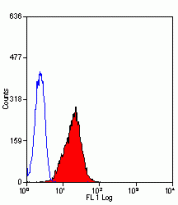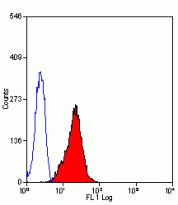ARG23266
anti-CD178 / Fas Ligand antibody [14C2]
anti-CD178 / Fas Ligand antibody [14C2] for ELISA,Flow cytometry,Immunoprecipitation and Human
Overview
| Product Description | Mouse Monoclonal antibody [14C2] recognizes CD178 / Fas Ligand |
|---|---|
| Tested Reactivity | Hu |
| Tested Application | ELISA, FACS, IP |
| Host | Mouse |
| Clonality | Monoclonal |
| Clone | 14C2 |
| Isotype | IgG1 |
| Target Name | CD178 / Fas Ligand |
| Antigen Species | Human |
| Conjugation | Un-conjugated |
| Alternate Names | FASLG; Fas Ligand; APT1LG1; TNFSF6; CD178; FasL; Tumor Necrosis Factor Ligand Superfamily Member 6; Fas Ligand (TNF Superfamily, Member 6); Apoptosis Antigen Ligand; Fas Antigen Ligand; CD95 Ligand; CD95-L; CD95L; APTL; FASL; Tumor Necrosis Factor (Ligand) Superfamily, Member 6; Mutant Tumor Necrosis Factor Family Member 6; Apoptosis (APO-1) Antigen Ligand 1; Tumor Necrosis Factor Ligand 1A; CD178 Antigen; ALPS1B; TNLG1A |
Application Instructions
| Application Suggestion |
|
||||||||
|---|---|---|---|---|---|---|---|---|---|
| Application Note | FACS: Results maybe enhanced using membrane permeabilisation. Use 10 µl of the suggested working dilution to label 10^6 cells in 100 µl. * The dilutions indicate recommended starting dilutions and the optimal dilutions or concentrations should be determined by the scientist. |
Properties
| Form | Liquid |
|---|---|
| Purification | Purification with Protein G. |
| Buffer | PBS and 0.09% Sodium azide. |
| Preservative | 0.09% Sodium azide |
| Concentration | 1 mg/ml |
| Storage Instruction | For continuous use, store undiluted antibody at 2-8°C for up to a week. For long-term storage, aliquot and store at -20°C or below. Storage in frost free freezers is not recommended. Avoid repeated freeze/thaw cycles. Suggest spin the vial prior to opening. The antibody solution should be gently mixed before use. |
| Note | For laboratory research only, not for drug, diagnostic or other use. |
Bioinformation
| Database Links |
Swiss-port # P48023 Human Tumor necrosis factor ligand superfamily member 6 |
|---|---|
| Gene Symbol | FASLG |
| Gene Full Name | Fas ligand (TNF superfamily, member 6) |
| Background | This gene is a member of the tumor necrosis factor superfamily. The primary function of the encoded transmembrane protein is the induction of apoptosis triggered by binding to FAS. The FAS/FASLG signaling pathway is essential for immune system regulation, including activation-induced cell death (AICD) of T cells and cytotoxic T lymphocyte induced cell death. It has also been implicated in the progression of several cancers. Defects in this gene may be related to some cases of systemic lupus erythematosus (SLE). Alternatively spliced transcript variants have been described. [provided by RefSeq, Nov 2014] |
| Function | Cytokine that binds to TNFRSF6/FAS, a receptor that transduces the apoptotic signal into cells. May be involved in cytotoxic T-cell mediated apoptosis and in T-cell development. TNFRSF6/FAS-mediated apoptosis may have a role in the induction of peripheral tolerance, in the antigen-stimulated suicide of mature T-cells, or both. Binding to the decoy receptor TNFRSF6B/DcR3 modulates its effects. The FasL intracellular domain (FasL ICD) cytoplasmic form induces gene transcription inhibition. [UniProt] |
| Calculated MW | 31 kDa |
| PTM | The soluble form derives from the membrane form by proteolytic processing. The membrane-bound form undergoes two successive intramembrane proteolytic cleavages. The first one is processed by ADAM10 producing an N-terminal fragment, which lacks the receptor-binding extracellular domain. This ADAM10-processed FasL (FasL APL) remnant form is still membrane anchored and further processed by SPPL2A that liberates the FasL intracellular domain (FasL ICD). FasL shedding by ADAM10 is a prerequisite for subsequent intramembrane cleavage by SPPL2A in T-cells. N-glycosylated (PubMed:9228058). Glycosylation enhances apoptotic activity (PubMed:27806260). Phosphorylated by FGR on tyrosine residues; this is required for ubiquitination and subsequent internalization. Monoubiquitinated. [UniProt] |
Images (3) Click the Picture to Zoom In
-
ARG23266 anti-CD178 / Fas Ligand antibody [14C2] FACS image
Flow Cytometry: Permeabilised Jurkat cells stained with ARG23266 anti-CD178 / Fas Ligand antibody [14C2].
-
ARG23266 anti-CD178 / Fas Ligand antibody [14C2] ELISA image
Sandwich ELISA: ARG23266 anti-CD178 / Fas Ligand antibody [14C2] as a capture reagent and biotinylated Mouse anti Human CD178 as a detection reagent with purified Human CD178 as antigen. Detection is by HRP conjugated Streptavidin and substrate. Microtitre plate is read at O.D. 450 nm on the Bio-Rad iMark Microplate Absorbance Reader (Bio-Rad Catalog 168-1135). Plasma (orange) sample is displayed at 1:2 dilution.
-
ARG23266 anti-CD178 / Fas Ligand antibody [14C2] FACS image
Flow Cytometry: Permeabilised Jurkat cells stained with ARG23266 anti-CD178 / Fas Ligand antibody [14C2].








